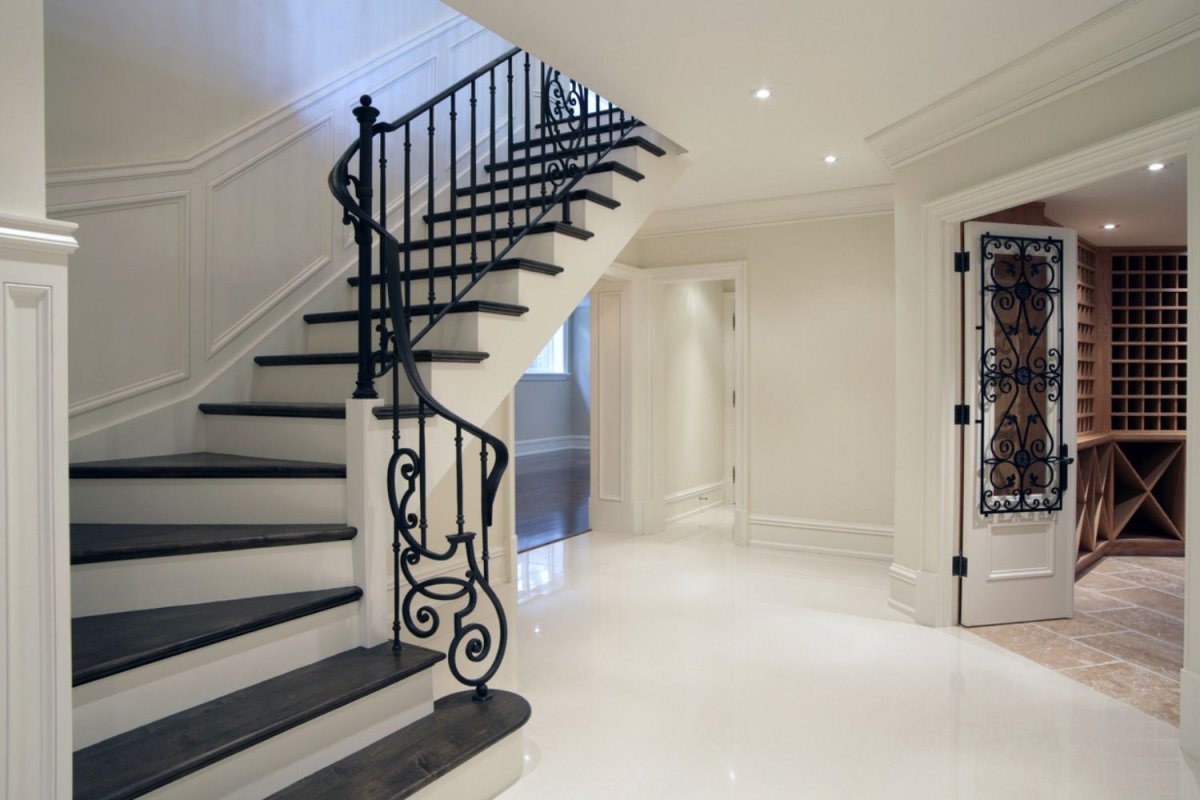

We may earn revenue from the products available on this page and participate in affiliate programs. Learn More ›
Highlights
- The typical price range to replace a stair railing runs from $200 to $10,000, though the national average cost is $900.
- There are several factors that can impact the cost of stair railing replacement, including railing length and material, baluster material, staircase location, and the cost of labor and permits.
- Some of the most common signs that stair railings need to be replaced are loose or unsteady railings, cracking or warping, rot or rust, broken or missing pieces, and pest infestation.
- A basic stair railing replacement may be doable by a homeowner with DIY skills. However, due to the potential danger of working at heights and the importance of safety, most homeowners will want to hire a professional.
Most people undervalue the security of a stable stair railing—until it’s suddenly rickety or broken. Take away that stair railing entirely, and everyone watches their footing more closely to avoid a fall. So before it gets to a dangerous point, homeowners are encouraged to start their stair railing replacement project and help keep the home’s occupants safe.
According to Angi and HomeAdvisor, the cost to replace a stair railing can run anywhere from $200 to $10,000, but many homeowners spend an average of $900 to install about 25 feet of railing. This cost applies to both outdoor and indoor stair railings made from wood, cable, steel, or other materials.
If the contractor bids the job by square foot, homeowners could pay between $30 and $80 per square foot for aluminum or wood stair railings. Alternatively, the cost per linear foot could run between $10 and $500 before labor. The railing length, material, installation location, and local labor rates will be the biggest factors for calculating replacement stair railing cost.
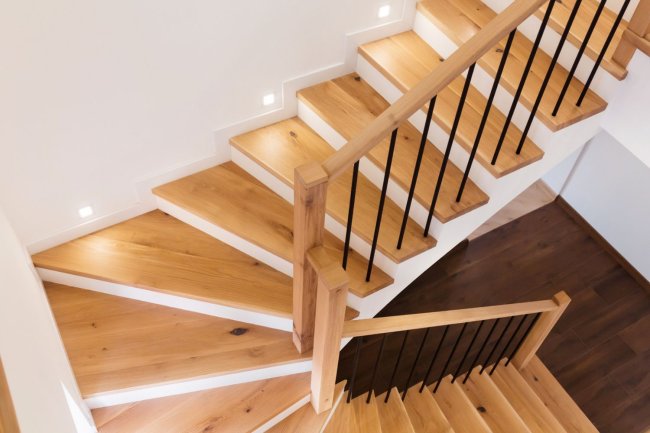
Factors in Calculating the Cost to Replace Stair Railings
As with many sizable construction projects, the overall length of the item being replaced will have the greatest impact on the final price. In this case, stair railings are often quoted by the square foot to account for the length of the railing and the balusters (vertical posts) that support it. Additionally, the kind of material a homeowner chooses will greatly affect the cost since wood is cheaper than a material like wrought iron. And if the staircase is difficult to access or has a steep slope, it can cost more to install.
Railing Length
The longer the railing, the higher the cost since more materials and labor are needed for installation. The cost for the cheapest materials averages $10 to $60 per linear foot, while more expensive materials can go as high as $500. The low-end average of $200 to replace stair railings would likely apply to a short, wooden railing to support just a few steps from the home to the ground. However, materials for a 20-foot glass stair railing could cost $2,000 to $10,000.
| 20-Foot Stair Railing Installation | Average Cost |
| Labor ($100 per hour for 6 hours) | $600 |
| Wood balusters ($3 each) | $180 |
| Wood railing ($25 per linear foot) | $500 |
| Wrought iron ($85 per linear foot) | $1,700 |
Railing and Baluster Material
One of the most important parts of a stair railing is the balusters, or vertical posts, which keep the railing straight and secure. It’s best to install about 3 balusters per foot, and they cost about $3 to $17 each for materials only.
The alternative is to use a material like cable or glass that offers durability and security without the need for balusters. These materials can come at a higher cost, so homeowners hoping for a more modern stair railing will need to plan a bigger budget. The most common railing materials are aluminum, cable, glass, stainless steel, wood, and wrought iron.
“Replacement costs are definitely affected by what type of materials the customer chooses,” explains Max McGonegal, general manager at Handyman Connection of Ann Arbor, Michigan. “There are many different variations with many price points. Wood is typically the cheapest and glass panes are usually the most expensive.”
Staircase Location
The cost to replace a stair railing is also influenced by its location. Steep, hard-to-access, or outdoor railings will typically cost more to replace. It’s more challenging for a contractor to work on stairs that are steep or difficult to access, so labor rates will increase. Outdoor stair railings could cost more since the materials need to be weather-resistant and secured in concrete or decking. Additionally, stairs with a unique shape like a curve or a spiral or with multiple corners may also have an increased total price.
Labor and Permits
Stair railing installation costs are heavily dependent on local labor rates. Local contractors and staircase builders are experienced and efficient at installing a variety of stair railings safely and up to code. Typical hourly rates average $70 to $150, and most installations take 6 to 10 hours. It’s possible that a complex job with delicate materials will take longer though.
Banisters for a staircase are usually regulated by local building codes, which is why it’s advantageous to leave this safety job to the pros. Homeowners may be unsure about necessary permits for stair remodeling jobs, but they can ask the stair builder about the process. Building permits have a wide cost range since the price depends on the extent of the project. If the homeowner is redoing stairs along with the railings, the permit could cost up to $2,000. A simple railing replacement for a small section could cost as little as $20.
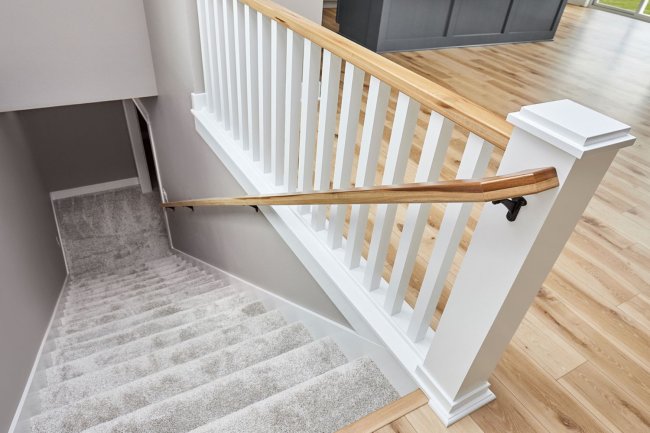
Additional Costs and Considerations
While factors such as railing length and labor will affect the cost to replace a stair railing, there may be other elements that could apply to certain situations. For instance, some homeowners prefer to install cheaper, prefabricated stair railings over custom designs. Additionally, any existing banisters will need to be removed before replacement, and finishing, refurbishing, and painting could be necessary.
Prefabricated vs. Custom Railings
Local hardware stores and many online retailers have prefabricated stair railings in a variety of materials and sizes. This can sometimes be cost-effective for homeowners since the kits can be cheaper. Many stair railing kits cost between $50 and $750, but it’s still a good idea to hire a stair builder or contractor to install the railing to ensure safety and stability. Experienced DIYers can learn how to build stairs, but the majority of homeowners wisely leave this important job to a pro.
Custom railings are ideal for homeowners who have specific design preferences. Stair builders and handrail manufacturers can provide homeowners with numerous customized designs for irregular shapes, unique materials, or extralong staircases. A curved iron staircase will cost significantly more than a standard-size wooden staircase (up to $900 per linear foot) but can be a stunning accent in a home and worth the cost if the budget allows.
| Type of Stair and Railing Design | Average Cost (Materials and Labor) |
| Arched or curved | $8,000 to $20,000 |
| Spiral or helical | $3,110 to $4,230 |
| Straight | $1,900 to $5,000 |
Existing Stair Railing Removal
Replacing a stair railing means the existing railing will have to be removed first. This is an easier job when the railing is wooden, but metal or iron railings in concrete will take much longer to fully remove. The cost to remove an existing railing is based on the average hourly labor rate of $70 to $150. If the foundation of concrete or bricks is significantly damaged during the removal process, it will need to be repaired at an additional cost before the new banister can be installed.
Refurbishing and Painting
Sometimes finish work is required to get the house back in shape after a stair remodeling project. Hiring a local handyman can help homeowners reclaim their home by taking care of any drywall repair or touch-up painting that needs to be done. Alternatively, hiring one of the best house painters (such as CertaPro Painters or 360° Painting) to do the touch-up work—or any additional wall painting—is another option. Handyman services typically cost $60 to $65 per hour, while painters either cost $20 to $50 per hour or charge up to $20 per linear foot to paint railings and balusters.
“Often, railings can be fixed just by adding some additional appropriately placed screws or hardware,” says McGonegal. “Balusters can also be bought and replaced individually as long as the same style can be found.”
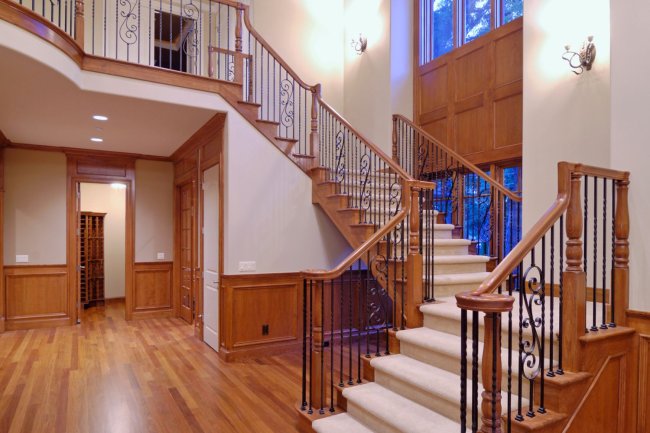
Cost to Replace Stair Railing by Type of Material
Stair railing replacement cost is heavily dependent on the type of material used. Wood is the cheapest material for building a banister, while glass and cable typically cost the most. All of these materials can be used both indoors and outdoors, though they each have varying levels of maintenance to promote longevity.
| Type of Stair Railing Material | Average Cost per Linear Foot (Materials and Labor) |
| Aluminum | $50 to $200 |
| Cable | $60 to $220 |
| Glass | $100 to $500 |
| Stainless steel | $25 to $110 |
| Wood | $10 to $40 |
| Wrought iron | $50 to $120 |
Aluminum
Many homeowners like the option of aluminum due to its durability and numerous finish options. Aluminum stair railings are frequently installed outdoors since they resist rusting and tend to withstand most weather conditions. Aluminum railings can be painted or powder-coated nearly any color to match a home’s appearance. The cost per linear foot to install an aluminum railing is $50 to $200.
Cable
Homeowners who love modern or industrial designs may prefer the sleek look of a cable stair railing. Unlike usual balusters, which stand vertically within the railing, cables are strung horizontally between each section. Cable railings can be made from metal, wood, or iron and painted almost any color to achieve the preferred look. The stainless steel or black color typically appeals to most homeowners though. The material cost for a cable stair railing is $60 to $220 per linear foot.
Glass
One of the most expensive options is a glass stair railing. For $100 to $500 per linear foot, homeowners can have a truly contemporary or minimalist look in their home. The glass can be clear, frosted, or cracked depending on the design preference. Each will come at its own installation cost, so while obtaining a quote, homeowners will want to ask specific questions about the type of glass available. The glass could be set within the metal frames of the railing, or it could free-float on the outer edge of the stairs with smoothed edges and corners. Glass typically encloses the stairs, which could reduce some cleaning time, though that’s easily done with one of the best vacuums for stairs.
Stainless Steel
A durable type of stair railing is stainless steel. Homeowners will pay around $25 to $110 per linear foot for stainless steel railing materials. It’s a versatile option that works both indoors and outdoors and can be painted, powder-coated, brushed, or polished to suit a homeowner’s style. Outdoor stainless steel railings are popular since they tend to last longer than wooden railings, which will succumb to water and UV damage in a shorter period of time.
Wood
The most classic type of stair railing is wood. Granted, this style is not as long-lasting as other types, but it can be crafted to suit a number of different interior design preferences. Proper treatment and care of an interior wood railing can help it last at least 10 years. Wood stair railings are the cheapest option at $10 to $40 per linear foot for materials, which is another reason they are a popular choice.
Wrought Iron
A railing made from wrought iron will catch the eyes of anyone walking by. Even a simple design exudes a luxurious appearance, much less a customized design with scrollwork. Homeowners will pay around $50 to $120 per linear foot for a standard wrought-iron railing, but customized designs could run as high as $900 per linear foot. The payoff is that an iron railing can last at least 100 years if well maintained.
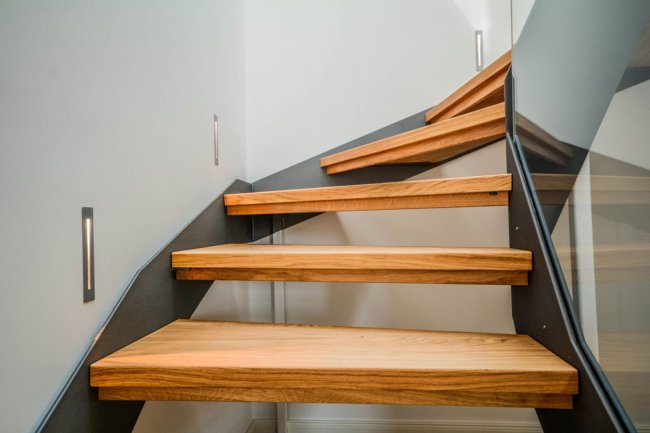
Do I need to replace my stair railings?
Stair railings often go unnoticed until they suddenly become unsteady or broken. Sometimes a railing is damaged due to an accident or pest infestation, but other times the damage happens over time due to continual use or weathering. Other times, a homeowner may just want to change the aesthetics of their staircase. “Typically, most homeowners replace stair railings due to a change in the surrounding aesthetics and they are looking for the stairs and railings to match,” explains McGonegal. Whatever the cause, homeowners will want to look at replacing their stair railing as soon as possible to ensure all of the home’s occupants can securely walk down the stairs.
Loose or Unsteady Railings
Railings can become loose or unsteady whether they’re located inside or outside. In some cases, the bolts just need to be tightened again. If that doesn’t do the trick, then there may be damage to the railings, and replacement will be the best corrective action. This is especially critical for railings located over a second-floor landing above the lower floor or on a set of stairs that can ice over in the winter. In both cases, the security of the railing is crucial for helping residents stay safe.
“Railings may begin to fail and become loose,” explains McGonegal. “They may start to wobble and just tightening a screw is no longer sufficient to keep them stable. The balusters may become loose or break and fall out, creating an unsafe situation.”
Cracking or Warping
A small flaw in any material can cause it to crack over time, especially when exposed to water and sun rays. Metal can also crack, but it may warp instead due to age, temperature fluctuations, or pressure. Either condition is a sign that the stair railing is no longer structurally sound. It’s possible that only a small section of the railing will need replacement, but it’s best to have a stair builder inspect the structure to be sure. If the railing cracked or warped due to pressure, an inspection will be needed to find a solution that will prevent the issue from happening again.
Rot or Rust
Wood that is intended for outdoor use is typically pretreated to help resist weathering and rotting. Still, as a natural material, wood will eventually break down. High-humidity rooms and wet climates can cause wood rot, which will show up as a darker spot that will eventually splinter into soft spots. The shorter life span means homeowners will want to keep an eye on a wooden railing to ensure it’s replaced before it becomes a safety concern.
Any piece of metal is susceptible to rusting or corrosion, and outdoor metal railings have the highest risk of rusting quickly. But even the screws in a wooden railing can corrode and cause wobbling. Any rusty parts on a railing make it unsafe and unable to withstand extra pressure or weight. This defeats the purpose of the railing, which means rusting parts are a sign that the railing needs to be replaced.
Broken or Missing Pieces
Older railings may be missing pieces that could have come loose or been broken by force. Not only does this make the railing unsightly and unappealing, but it can become a safety hazard since the railing is not as structurally secure. If only a couple balusters are missing, they could be replaced individually. However, if several are missing, or if part of the handrail is damaged or missing, then it’s best to simply replace the entire railing.
Pest Infestation
Wood railings, especially if they’re outdoors, can attract insects that are detrimental to the railings’ condition. Termites, carpenter ants and bees, and wasps can all take up residence in wooden stairs and threaten the integrity of the wood. Some insects prefer to burrow into rotting wood, while others don’t seem to mind dry wood. The termite or carpenter ant damage can go unnoticed for a while until it’s irreparable and the stair railing requires full replacement. If the home is located in a heavily wooded area, it might be best for homeowners to consider a more durable replacement material that won’t attract insects.
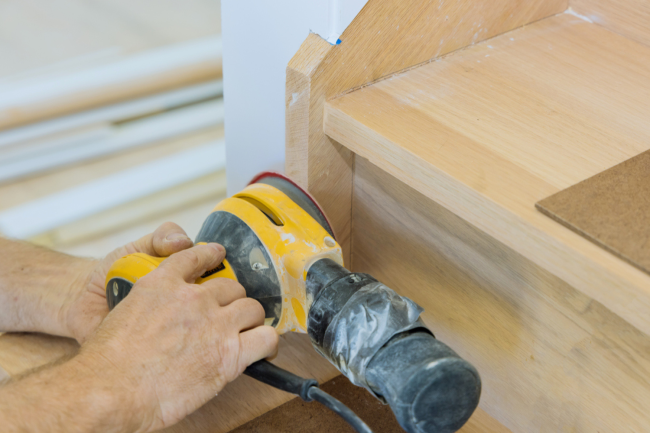
Replacing Stair Railings: DIY vs. Hiring a Professional
The safety and security of stair railings for protecting the home’s occupants are crucial. While some experienced DIY homeowners may have the tools and expertise to replace missing balusters or even install a small wooden railing on their deck steps, most homeowners are unfamiliar with safety protocols for installing stair railings.
“A homeowner who has a decent grasp of carpentry should be able to repair or replace most straight railings,” says McGonegal. “A professional should be called in for a curved railing, however.”
In fact, local building codes recommend specific deck railing heights, which many homeowners might not even know about. Additionally, most residential railing installations require a building permit, which indicates how important it is to install them correctly.
According to McGonegal, “A handrail should be between 34 and 38 inches above the front of the stair tread, [and] the handrail should be shaped to allow a good handhold when grasped and should follow the slope of the stairs. The handrails should be continuous for the full length of the stairs, the ends should be returned into the walls or may terminate at a newel post, and there should not be any gap larger than 4 inches between balusters.”
A stair builder or contractor is the best bet for a successful installation that will last the expected number of years. Professionals already have the tools and equipment necessary to install the railing and stairs. And if the homeowner has opted to install a unique railing made of glass or iron, then professional installation is a must. Handling special materials requires experience, and if a mistake is made during installation, then the installer is responsible rather than the homeowner—saving them money.
How to Save Money on the Cost to Replace Stair Railings
Labor is a big component of the cost to replace stair railings, which is why homeowners often look for ways to save money on this important project. Granted, the cost of installation pays off with the peace of mind that comes with knowing the railing is securely installed. Nevertheless, homeowners can opt for several ways to stretch their dollar during their stair remodeling project.
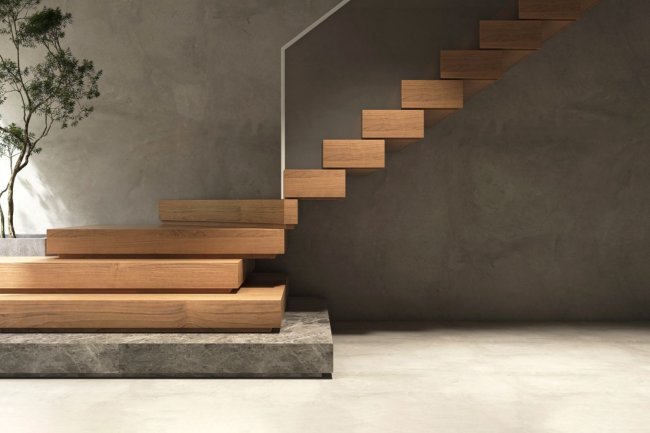
- Shop around. To find the right price and value for the project, asking for quotes from multiple contractors is always a good idea.
- Choose a cheaper material. Wood, aluminum, and stainless steel are good options for homeowners looking to install a stair railing without paying exorbitant material costs.
- Buy your own stair railing kit locally. Many local hardware stores offer good-looking and durable stair railing kits at a lower price than many contractors can offer for the materials. Then homeowners need to pay contractors only for installation.
- DIY stair railing removal. Homeowners who feel comfortable doing a little demolition project can remove their own railings and balusters when possible. This is more challenging with certain materials like iron, but it can save on some labor costs.
- Bundle projects. Homeowners who bundle construction projects tend to save on labor costs in the long run since the contractor can do more in fewer trips. Building stairs at the same time as railings or understair storage can reduce total costs.
- DIY the finish work. Sometimes a homeowner may prefer to do their own finish work if they have the skills and tools to do so. They may even want to learn how to paint a staircase to give their newly remodeled stairs a little flair without having to spend too much.
- Try to schedule in the off-season. While timing can’t always be controlled, small indoor construction projects can cost less overall during the off-season since many contractors are looking for work.
Questions to Ask About Replacing Stair Railings
When it’s time to start planning for a stair railing replacement, homeowners may wonder about their material options, what the project will cost, and what to expect. Asking lots of questions during the vetting process can help homeowners find a contractor they feel comfortable working with.
- How long have you been in business?
- How many stairs and stair railings have you installed?
- Are you licensed and insured?
- Do you know what permit my project will require?
- Will you obtain the permit for me?
- What kind of material would you recommend within my budget?
- Have you worked with my preferred material before?
- I’ve drawn a design I’d like to install. Does it raise any safety or design concerns?
- How much will it cost to install?
- Do you offer a guaranteed maximum cost for this project?
- How long will it take?
- Do you have any discounted leftover materials from another job I can purchase?
- If I buy a DIY kit, will you do the installation?
- What do you charge to remove and haul away my existing railing?
- How will you protect the rest of my property during installation?
- How much of the concrete or brick in the stair’s foundationwill be damaged during the removal process?
- If there is damage, will you repair it or subcontract someone else? If so, how much will that cost?
- Will you complete any finish work such as painting? If so, how much will that cost?
- What will it cost if I want to have new stairs installed as well?
- Can I just replace the missing balusters instead of replacing the entire railing?
- Is this type of stair railing safe for children?
- Will this material resist weathering?
- How much will a custom-built railing cost for my staircase?
- Do you warranty or guarantee your work?
- How will you clean up after the project?
- If I’m not satisfied with the cleanup, how can I have it resolved quickly?
FAQs
It’s always a good idea for homeowners to research the costs and expectations for new construction projects. There is a lot of information available about the cost to replace a stair railing, including these commonly asked questions and their answers.
Q. Who installs stair railings?
There are a number of professionals who can install stair railings. To some degree, it depends on the type of material. An outdoor iron railing could require the help of a concrete or brick worker, in addition to an ironworker. On the other hand, an indoor wooden railing could be installed by a contractor, handyman, carpenter, or stair builder. Metal fabricators may have installers available to help with custom railings too. Speaking with a local contractor or searching the internet for “stair builders near me” can help homeowners find the right person for their metal, glass, or wooden stair railing project.
Q. How high should a stair railing be?
Most railings are at least 34 to 38 inches high. For extra security, some homes have taller railings on landings that open to a lower floor, but this will come at a cost, since it may be considered a custom railing. Local building codes may also dictate a minimum height for a stair railing.
Q. Do all staircases need a handrail?
It’s common for staircases to have a handrail, and in many cases, it’s mandatory for local building codes. However, when the stairs are just a few steps, a handrail may not be necessary. Typically, railings are recommended for four or more steps.
Sources: HomeAdvisor, Angi, HomeGuide, Yelp
